Panasonic Lumix DMC-LF1 Review
Panasonic Lumix DMC-LF1 Introduction
The Panasonic Lumix DMC-LF1 is the smallest premium compact camera with a built-in EVF. Its amazingly small body features dual control-dials and a relatively powerful 7X wide-angle optical zoom lens. Its sensor captures 16 megapixels images at ISO 80 to 12800 and records full 1080p HD video at 30 FPS.
The LF1 is designed for advanced photographers looking for efficient manual controls in a compact camera. This can be people looking for a compact model where larger equipment is cumbersome or beginners looking to learn photography. For either type of user, this digital camera offers full manual-controls including manual-focus, choice of metering patterns including Spot and custom white-balance.
This advanced camera delivers the most extreme miniaturization of its peers. Having a built-in EVF makes it more usable in bright light while providing a sense of connection between photographer and subject.
This camera review covers the usability and performance of the Panasonic Lumix DMC-LF1.
Panasonic Lumix DMC-LF1 Features
Sensor & Exposure
- 12 Megapixels CMOS sensor
- ISO 80 - 6400 sensitivity at full-resolution
- Expanded ISO 12800 sensitivity
- Auto ISO based on light-levels and movement
- 1/4000 - 250s Shutter-speeds
- PASM Exposure modes for both stills and video
- Exposure-Compensation, ±2 in 1/3 EV increments
- Multi-Segment, Center-Weighed and Spot metering modes
Lens
- Wide 28 - 200mm equivalent 7X optical zoom
- F/2 - 5.9 Maximum aperture, F/8 Minimum
- Optical image stabilization
- 50cm (W) - 80cm (T) Normal minimum focus
- 3cm (W) - 30m (T) Macro minimum focus
Image Parameters
- Automatic, 4 presetsDaylight, Cloudy, Shade, Incandescent, Kelvin and custom white-balance, 2 memories
- WB fine-tuning, 21 steps along Red-Blue axis
- White-Balance bracketing, 3 frames
- Standard, Vivid, Monochrome and Sepia color modes
- Selectable 4:3, 3:2, 16:9 or 1:1 aspect-ratio
- JPEG, RAW or RAW+JPEG output
- 2 JPEG Quality levels
- Optional Intelligent Exposure tone
Focus
- Normal, Macro and Manual focus modes
- Single, Automatic, Tracking and Face-Detect focus-point selection
- Optional AF-Assist lamp
- Optional MF-Assist
- Optional Quick AF
- Optional Face-Recognition
Drive
- Single-Shot drive mode
- Self-Timer: 2s, 10s or 3 shots @ 10s
- 10 FPS Drive, focus locked at first-frame
- 5 or 2 FPS Drive, focusing between frames
- 40 FPS @ 5 MP, focus locked at first-frame
- 60 FPS @ 2.5 MP, reduced field-of-view, focus locked at first-frame
- 1 FPS Flash-Burst, full-resolution
- AEB, 3 frames, maximum ±3 EV
Display & Viewfinder
- 3" LCD, 920K Pixels
- 0.2" EVF, 200K Pixels
- 2-Axis Digital-Level
- Adjustable LCD brightness
- Adjustable LCD contrast-saturation
- Adjustable LCD tint, 2 axis
- Optional Live-Histogram
- 16 Optional framing grids
Video
- 1920x1080 @ 60i FPS AVCHD
- 1920x1080 @ 30 FPS MPEG-4
- 1280x720 @ 60 FPS MPEG-4
- AF-S or AF-C focus
- Optional wind-filter
- Optional video framing mask
Flash
- Auto, Auto Redeye, Forced, Redeye & Slow-Sync flash modes
- Optional redeye removal
Connectivity
- HDMI (1080i) output
- A/V (NTSC / PAL) output
- USB 2.0 connectivity
Misc
- Dual control-dials
- Customizable Fn button
- Customizable AE-L/AF-L behavior
- Sweep Panorama mode
- Built-in HDR mode
- 16 Scene-Modes
- Built-in WiFi
- Built-in NFC
- Lithium-Ion battery
- Internal charging via USB
- SDXC memory
Panasonic Lumix DMC-LF1 Usability - How easy is it to use?
The ultra-compact Panasonic Lumix DMC-LF1 can only be described as adorable. This miniature camera offers dual control-dials and, for the first time on such a small model, a built EVF. There are a high number of buttons and a traditional mode-dial too. The only thing missing is a hand-grip of sorts.
Panasonic is the pioneer of travel-zooms, having launched the category already 8 years ago. They were also among the first to offer a premium compact, so it makes sense that they are one of the few to offer a premium camera with a long zoom. The LF1 is of course not an ultra-zoom yet it packs an impressive 28-200mm lens in its compact body.
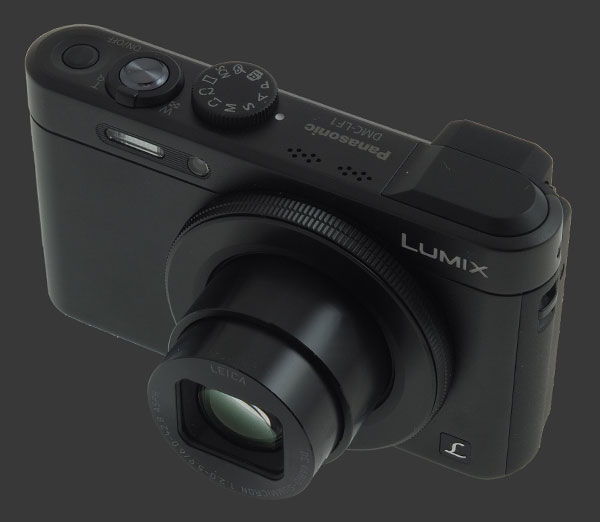
To deliver a highly versatile and efficient experience, the LF1 must necessarily compromise somewhere. It does so by using a standard-sized 1/2.3" CMOS sensor with 12 megapixels and an F/2 lens which closes down to a dim F/5.9 near its telephoto end. This puts it on par with typical compacts when it comes to image-quality. Most premium models offer a larger sensor to improve low-light performance.
The front of the LF1 is smooth and relatively sparse. One sees there the lens barrel which protrudes to form the front control-dial. There is also a small built-in flash and led assist-lamp. The provided hand-strap is a must to keep the camera secure, given how slippery its front surface is.
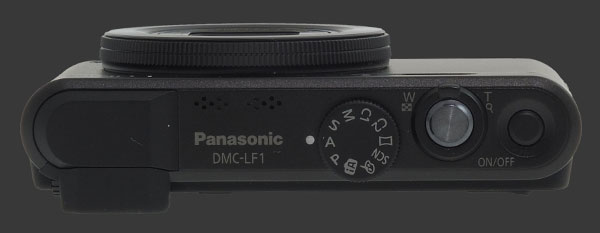
The top-plate of this digital camera has a slightly elevated side to accommodate the built-in EVF. A pair of small microphones to record stereo sound can be seen just to the right of the EVF. Further right, there is a traditional mode-dial with the usual PASM positions, plus 6 additional modes.
Next to the mode-dial, there is a two-stage shutter-release surrounded by a zoom controller. The release has a moderate amount of travel with a soft halfway point. The zoom operates in small incremental step which allow for good framing precision. Near the right edge of the camera, there is a recessed power-button which turns the camera immediately on or off.
The sides of this camera are quite bare. Oddly for a small camera, there is a strap eyelet on both sides. They are nicely inset in the body. Below the right eyelet, a small hard plastic door opens to reveal a Micro-HDMI and a combined proprietary USB/Analog connector. Panasonic supplies a USB cable to charge the camera using the latter connector as there is no external charger.
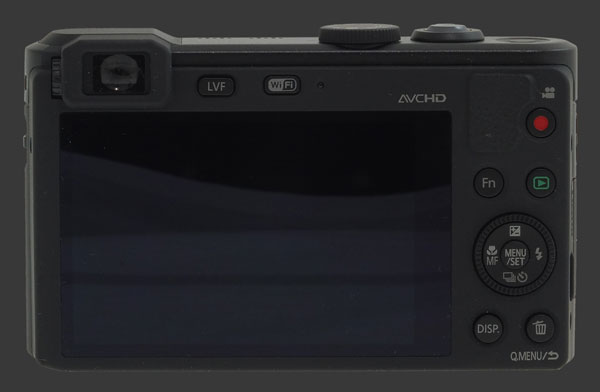
From the back, the Panasonic Lumix DMC-LF1 looks extremely busy. A large 3" LCD with 920K pixels and 3:2 aspect-ratio dominates the surface. The view is bright and sharp with an excellent viewing angle. The LCD can be adjusted better than most cameras. It has separate controls for brightness, saturation-contrast and tint in 2 axis. The optional Power mode keeps the image extra bright for outdoor use, while Standard mode maintains a more typical view which helps with battery-life. A third option automatically switches between these Power and Standard mode.
At the upper-left corner of the back, one finds the headline built-in EVF. No other camera this small has one. This viewfinder is small, measuring 0.2" across, with a low 200K pixels resolution. Still, the makes the LF1 more usable in bright light and more stable than its peers. It also afford better discretion and makes precise framing easier. A button to the right of the EVF toggles between it and the rear LCD.
The resolution of the EVF is clearly too low to judge focus but the LCD shows it reasonably well. Both the EVF and LCD show the metered preview while framing and an Exposure-Priority view while pressing the shutter-release halfway. This is not perfect yet much better than most cameras lately.
The LF1 offers no less than 16 overlays to compose images. Most importantly, since this camera has no Video mode, one most enable the Recording Area mask which shades what appears outside of the video-recording area in order to make framing video possible with any degree of accuracy.
Above the LCD, there also a WiFi button which, unsurprisingly, activates the built-in WiFi by bringing up directly the WiFi menu. To the right of the display, there are 5 buttons and a 4-way controller surrounded by a very slim control-dial. The top button starts and stops video-recording. Below it, a button toggles Playback mode. This camera is Shooting-Priority, so tapping the shutter-release brings returns it to Capture mode.
There is a customizable Fn button which can be set to one of 8 functions: AE-L/AF-L, AF-On, Metering Mode, AF Mode, Focus-Area Selection, Image Quality, Composition Grid or Histogram. The 4-way controller has functions assigned to each of its cardinal directions:
- Up: Exposure-Compensation. Once pressed, the rear control-dial sets EC.
- Right: Brings up a vertical menu to select the Flash mode.
- Down: Brings up a vertical menu to select the Drive mode. Most of these can be further configured by pressing Disp. AEB and Self-Timers are set here, so they are mutually exclusive.
- Left: Selects between Normal, Macro, Digital Macro or Manual focus.
The central button of the 4-way controller brings up a choice of 4 menu systems. This makes it less efficient than most cameras which directly enter the Shooting menu. Choices are Rec, Motion Picture, Setup and WiFi. The Disp button below cycles over display modes, as usual. Another button next to it invokes the Quick menu in Capture mode and deletes images in Playback mode.
Dual control-dials on the LF1 work quite efficiently. While the rear dial always controls the primary exposure-parameter, the front dial is customizable. It can be set to Default which makes it redundant with the rear-dial except in Manual mode where it controls Aperture and the rear one sets Shutter-Speed.
The control-ring can be configured to set the zoom in 8 pseudo-standard steps, adjust EC, Aspect-Ratio, ISO or WB. Obviously, ISO is the most useful option. This only makes Manual exposure slightly more cumbersome as one must press the Up direction of the 4-way controller to toggle between exposure parameters.
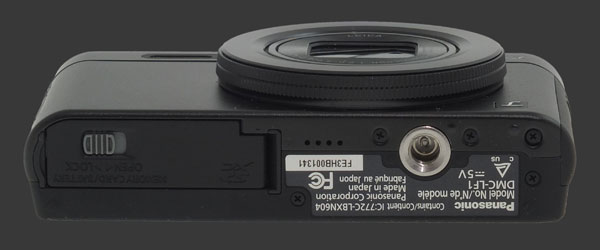
The bottom of the Panasonic Lumix DMC-LF1 is fitted with a metal tripod-mount which is neither inline with the lens nor the center of gravity of the camera. A light-weight and flexible plastic door covers the combined SDXC and Lithium-Ion battery compartment. The battery used by this camera is very small and extremely sensitive to cold. While normal battery-life is quoted at 250 shots-per-charge, there is no way to get a tenth of that at freezing temperatures.
Panasonic Lumix DMC-LF1 Performance - How well does it take pictures?
Choosing a digital camera is all about results: Getting the image quality you need and photographs the way you like them. The Panasonic Lumix DMC-LF1 provides efficient controls while remaining extremely compact to help with the latter. It does however maintain a similar sensor and optics to most small cameras.
The LF1 features a 12 megapixels 1/2.3" CMOS. Its resolution is certainly sufficient for the most common print-sizes, even moderately large ones as long as ISO is kept low. Being one of the smallest sensors in use among digital cameras, it is highly susceptible to image-noise which increases quickly with ISO.
Image-noise is nearly invisible at ISO 80 and 100. It is barely apparent at ISO 200 and only starts damaging the finest details at ISO 400. Up to this sensitivity though, this digital camera can produce large usable 16" x 12" prints. Still, there is always a slight softness visible at 100% which makes the largest prints less than perfectly sharp. A good performance for a compact yet not up to par with most premium models.
Noise becomes stronger at ISO 800 and even more so at 1600. In both cases, more fine details get destroyed yet mid-size 12" x 9" prints are still quite acceptable. Image-noise-reduction is surprisingly gentle and does not introduce much additional softness until this point.
ISO 3200 and 6400 are quite noisy and blurry. While the former can pull-off a small 4" x 6" print, the latter should be reserved for emergencies only. The expanded ISO 12800 is pretty much useless though.
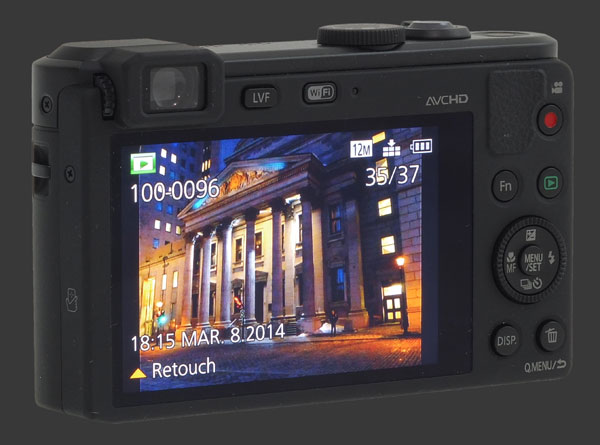
Despite having outstanding controls over colors of the LCD, there are no controls over image colors other than the Color Mode. The Standard mode is as close to reality as the Lumix LF1 can get which is not natural at all. It produces images with too much red even with Custom WB properly set.
White-Balance is flexible with fine-grained control over tint along the Red-Blue axis. This can improve realism yet takes more time to setup. Automatic WB is average. It often leaves a slight yellow tint in low-light but even in bright light does not nail it every time. Results are sometimes too warm and sometimes too cold.
The Panasonic Lumix DMC-LF1 offers no control at all over noise-reduction. Thankfully, Panasonic applies very reasonable noise-reduction which balances out noise and details very well for such a small sensor. The lens appears to be suitably sharp for most common print sizes. While one cannot get out the maximum sharpness possible from a 12 megapixels sensor, rendition of details is respectable for compact lens.
The Multi-Segment metering of the LF1 is good and visibly improved over previous compacts from Panasonic. Its limited dynamic-range means that small highlights are often clipped in order to preserve shadow details yet exposures appear natural in general. Panasonic's built-in HDR mode provides relief for static scenes having a wide dynamic-range without appearing completely unreal.
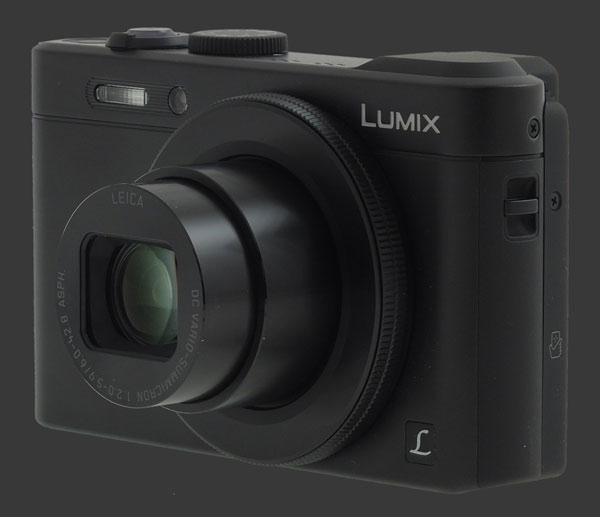
The 28-200mm F/2-5.9 lens of the LF1 is impressively compact. There is a slight amount of barrel distortion at the wide-angle end which quickly disappears after zooming in. Vignetting is remarkably absent throughout the focal-range, as are chromatic aberrations.
The high-speed CMOS sensor on this Panasonic lets it shoot extremely quickly. Full-resolution bursts up to 10 FPS are possible. At 5 MP, speed increased to 40 FPS, while at 2.5 MP in can reach 60 FPS. Keep in mind that focus is locked on the first-frame above 5 FPS and the 60 FPS drive crops the field-of-view.
Movie capture takes advantage of the high-speed sensor which is read at up to 60 FPS. Sadly, half the pixels are dropped and the LF1 can either record 1080i @ 60 FPS with the AVCHD codec or 1080p @ 30 FPS with MPEG-4. The latter offers a slightly higher 20 Mb/s versus the former's 17 Mb/s. There is also a 720p 60 FPS mode to render action more smoothly.
Once on, the Lumix LF1 is generally quite responsive. The camera starts reacting immediately to most button presses and continues to do so while it is writing to the memory card. For long exposures, the camera employs dark-frame substraction which locks it up for a duration equal to the exposure time. A nice touch is that the LF1 counts down the exposure time and the dark-frame substraction time, so the photographer knows how much patience is needed.
The performance of this compact digital camera is characterized by the following measurements:
- Power On: 2s. Average for an extending lens camera. Twice that if the Lens Resume option is on.
- Autofocus: ¼s in moderate to good light. Down to 1s in low-light at the long end of the zoom. Better than average.
- Zoom: About 3s from widest to longest. Very slow.
- Image Shutter-Lag: Instant. Excellent.
- Video Shutter-Lag: 1s. Below average.
- Black Out: ¼s. Excellent.
- Shot-to-Shot speed: 1s, a tad more with AF, slightly less with MF. Good.
- Time-to-first shot: 2½s. Good considering most of that time is spend powering on. Longer if the Lens Resume option is selected.
- Playback: About ½s to enter or exit, assuming the lens is still extended. Average.
- Power Off: 2s. Slow. This is from wide-angle. Longer with the lens zoomed in.
The Panasonic LF1 is really fast in several key metric. Shutter-lag, black-out and shot-to-shot speeds are great. Autofocus ranges from quite fast to relatively slow near telephoto because the lens gets so dim. Between F/2 and F/5.9, there are more than two stops of light less, so the AF-system must work with much less light when zoomed-in. Speaking of the zoom, it could really stand to be faster. Other below average aspects are of minor importance to photographers.
Battery-life of the LF1 is short at 250 shots-per-charge, according to the CIPA measurement standard. This is exasperated in the cold when the small battery struggles to supply current. At least one extra battery is needed to last a full day of shooting.
Panasonic Lumix DMC-LF1 Conclusion
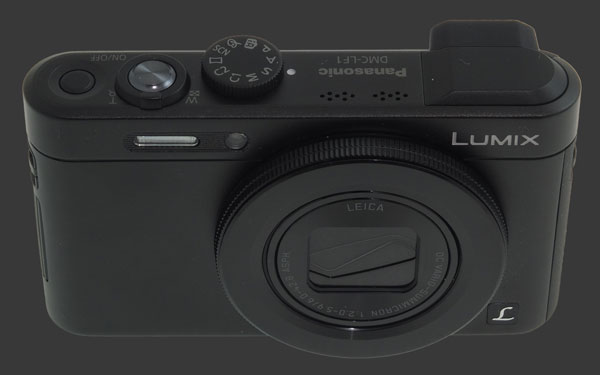
The Panasonic Lumix DMC-LF1 is a unique compact which provides efficient photographic controls and a built-in EVF in a very small and solid body. Its dual control-dials, traditional mode-dial and viewfinder together make it more pleasing to use than other ultra-compact. Its controls reveal an amazingly powerful camera with a ISO 80-12800 sensitivity range and shutter-speeds from 1/4000s to a class-leading 250s.
The wide-angle 28-200mm lens, delivering a stabilized 7X optical zoom range, is highly versatile and starts off at a relatively bright F/2 before it dim down to a slow F/5.9 at the long end. This lens which retracts into the LF1 save for the thickness of the control-ring is optically impressive. It is remains acceptably sharp from corner-to-corner with little distortion and no sign of vignetting or chromatic aberrations.
The 12 megapixels 1/2.3" CMOS sensor which is typical of small cameras performs as expected. It delivers low noise images from ISO 80 to 400 before print sizes drop noticeably. It remains unusually usable for small prints up to ISO 3200 thanks to well-balanced image-processing. However, colors and WB could be improved.
Speed of the LF1 is quite good too. While zooming could be faster, the autofocus system manages to lock quickly when wide-apertures are possible. Shutter-lag and black-out times are very good, while shot-to-shot speeds are quite respectable. There is an unfortunate 1s delay when starting to record video though.
The Panasonic Lumix DMC-LF1 is certainly an appealing digital camera. Its direct controls and broad range of exposure parameters make it ideal to learn photography with. It is also a great model for photographers who enjoy being creative and are not asking for exhibition-quality prints.
 |
Please Support Neocamera
All information on Neocamera is provided free of charge yet running this website is a huge endeavor. Purchases made via affiliate links found throughout the site help keep it running and up-to-date. There is no additional cost to you, so please consider buying via these links to our affilates:
Thank you for your support!
Panasonic DMC-LF1 Highlights
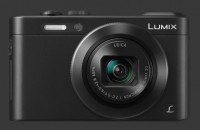
Sensor-Size: 8 x 6mm

Actual size when viewed at 100 DPI
| 12 Megapixels Fixed Lens | ISO 80-12800 |
| 7.1X Wide Optical Zoom | Shutter 1/4000-250s |
| Built-in Stabilization | Full manual controls, including Manual Focus |
| 0.20" Built-in EVF 200K Pixels | Custom white-balance with 2 axis fine-tuning |
| 10 FPS Drive, 12 Images | Spot-Metering |
| 1920x1080 @ 30 FPS Video Recording | Lithium-Ion Battery |
| 3" LCD 920K Pixels | Secure Digital Extended Capacity, Internal Memory |
Updates
2025.11.13

Best Gifts for Photographers in 2025 by Budget
The annual Neocamera Photography Gift Guide updated to 2025. Find great gifts for photographers with any price budget.
2025.07.07

Stellar Photo Recovery Review
Review of Stellar Photo Recovery V12. This Windows and MacOS software can recover photos and videos in a huge number of formats from memory cards, USB drives, SSDs and HHDs.
2025.05.14

Huion Kamvas 13 Gen 3 Review
In-Depth review of the Huion Kamvas 13 Gen 3 Pen Display Tablet for photographers and graphic artists.
2025.01.18

Fujifilm GFX 2025 Lens Roundup
Lens Review roundup of Fujifilm GFX Medium-Format lenses. Quality, performance and handling of the GF20-35mm F/4R WR, GF30mm F/3.5 Tilt-Shift and the GF55mm F/1.7.
2024.11.18

Best 2024 Photography Gifts for Every Budget
Great gifts for photographers and photo enthusiasts selected for every budget among the best products of 2024.
2024.08.07

Eye Protection Tips for Professional Photographers
The four main considerations for professional photographers regarding eyewear.
2024.07.14

Fujifilm X100VI Review
Flagship fixed-lens compact digital camera with a 40 MP sensor and Image-Stabilization, a first for the series. Retro design featuring dual control-dials, plus direct ISO, Shutter-Speed and EC dials. Its hybrid viewfinder can switch between EVF and OVF mode.
2024.05.09

Fujifilm GFX100 II Review
Flagship 102 Megapixels Medium-Format Mirrorless Digital Camera with 8-Stop 5-Axis IBIS, 8 FPS Drive, 8K Video and 400 MP Super-Resolution capture in a weatherproof and freezeproof body with dual control-dials and dual memory-card slots.
2024.04.03

Fujifilm X-T5 Review
Newest Fujifilm flagship boasting a 40 MP APS-C sensor, 5-axis IBIS with 7-stop efficiency, 15 FPS continuous drive, 6.2K Video capture, dual control-dials and dual SDXC UHS-II slots in a sturdy weatherproof and freezeproof body.
2023.11.20

Best Digital Cameras of 2023
Find out which are the Best Digital Cameras of 2023. All the new Mirrorless Digital Cameras from entry-level to high-end professional.
2023.07.10

Fujifilm X-H2 Review
40 Megapixels APS-C Hybrid Mirrorless Digital Camera with 7-stop IBIS. Fastest shutter ever and 8K video capture. Large builtin EVF with 0.8X magnification and 5.8 MP, plus an Eye-Start Sensor. Packed with features and large number of controls in a weatherproof and freezeproof body.
2023.05.07

Sony FE 20-70mm F/4G Review
Review of the unique Sony FE 20-70mm F/4G lens. The optical zoom of this lens spans ultra-wide-angle and medium focal-length coverage, making it one of the most versatile Full-Frame lenses on the market.













